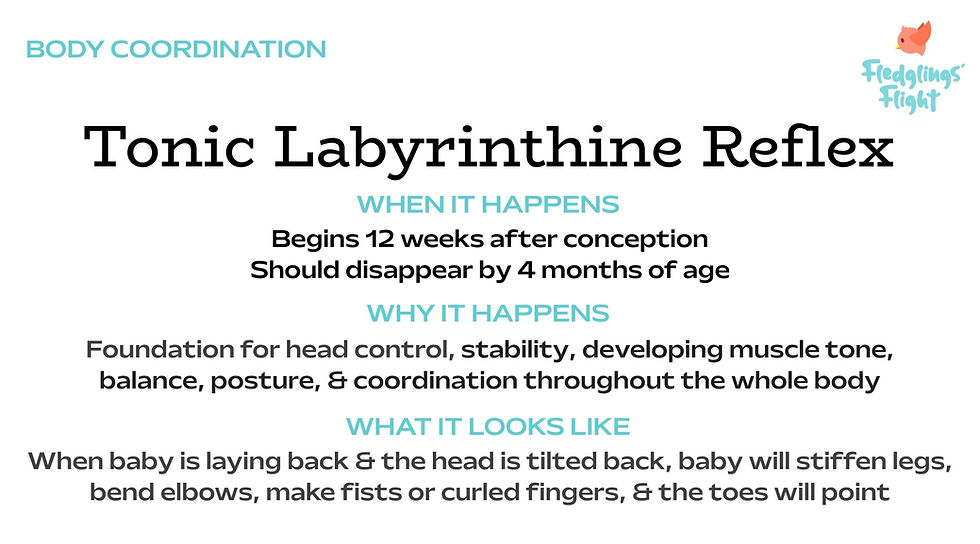Early Steps: How the Plantar Reflex Prepares Babies for Walking
- Kaylie Estrada
- Sep 16, 2025
- 3 min read
Updated: Sep 25, 2025
The Plantar Reflex makes your baby’s toes curl and helps them balance on their feet.

What are primitive reflexes?
Primitive reflexes are automatic responses that babies are born with and they serve to provide the basis for basic movement, balance, and strength. Each reflex plays a unique role in preparing the body for voluntary control.
Among these are mobility reflexes, which are especially important because they help babies transition from reflexive responses to complex movement like crawling. The Plantar Reflex, which we will talking about, is triggered when the sole of the foot is stroked and lays the groundwork for balance. Closely tied to this is the Stepping Reflex, where newborns instinctively make a walking motion when their feet touch a flat surface. While temporary, these reflexes act as practice for bigger milestones and teach the body how to coordinate.
Primitive reflexes support babies in many ways from feeding reflexes like the Sucking Reflex which ensure babies can eat from birth, while the Moro Reflex provides early self-preservation. Others, such as the Asymmetric Tonic Neck Reflex, the Spinal Galant Reflex, and the Tonic Labyrinthine Reflex, help with body coordination, crawling, posture, and balance. Together, these reflexes help your baby with basic movement and survival until voluntary movement takes over.

What is the Plantar Reflex?
The Plantar Reflex appears very early, even before birth, and can be seen when the bottom of your baby’s foot is gently stroked. In response, their toes will spread out or curl inward, which is an automatic reaction that tells us their nervous system is developing as it should. This reflex strengthens the muscles of the feet and legs, supports balance, and prepares the body for skills like crawling and later, walking.
During the first year of life, the Plantar Reflex is incredibly important in mobility development. By around 7–9 months of age, it should begin to fade as your baby learns to move their legs and feet voluntarily. Once the reflex is integrated, your baby can better balance on their feet coordinate their movements.

What happens if the Plantar Reflex Lingers?
When the Plantar Reflex remains active past 9 months, it can affect the way your child moves and processes sensory information in the future. Children with a retained Plantar Reflex might struggle with balance, show patterns of toe-walking, be prone to sprains, and are even at risk of developing motion sickness. Overstimulation of the senses are also linked to this reflex when it lingers for too long. These challenges can make activities such as running and climbing much more difficult for your child. Because the reflex is tied to the body’s awareness of movement and position, it can also interfere with overall coordination and confidence while playing.

How to test for a retained Plantar Reflex
To see whether the reflex is still active, gently stroke the sole of your baby's foot. In babies under 7 months, the toes will naturally curl in response to touch, and over time this reaction should begin to change. In fact, researchers note that in the first months of life, babies’ toes usually point upward when the bottom of the foot is touched. After about 6 months, this starts to change so the toes curl downward instead [4]. By around 8–9 months, the reflex should gradually disappear. If the toes still flex noticeably beyond this point, this may suggest that the reflex hasn’t fully integrated.

What can you do about a retained Plantar Reflex?
If you notice signs of a lingering Plantar Reflex, the first steps are observation and awareness. Pediatricians and reflex integration specialists can evaluate your child and recommend exercises or therapies to support their continuous development. Early support is important, since retained reflexes can influence not just motor skills but also things such as focus, and sensory processing. With the right guidance, children can overcome the challenges that come with retained reflexes and continue to strengthen their coordination and move toward more confidence as they grow.
Sources:
Lewis, R. (2020, May 19). What are the primitive reflexes and how are they useful? Healthline. https://www.healthline.com/health/baby/primitive-reflexes?utm
Brain Balance Centers. Retained Primitive Reflexes as a Sign of Brain Imbalance. https://www.brainbalancecenters.com/blog/retained-primitive-reflexes-sign-brain-imbalance
Understanding Primitive Reflexes: A Dynamic Perspective on Sensory Motor Development. (n.d.). Sensory Health. https://sensoryhealth.org/node/2060
Kumhar, G. “Plantar Response in Infancy.” European Journal of Paediatric Neurology, vol. 6, no. 6, Oct. 2002, pp. 321–25. https://doi.org/10.1016/s1090-3798(02)90620-3.

Want more information like this?
Create a free account with Fledglings' Flight and get access to 4820 screen-free, play-based exercises. That is 100-200 exercises each month that you can start doing with your baby from the day that they are born to help them to develop into the best version of themselves. In addition, your free account gives you access to 1200+ articles on child development to keep you informed while you help to navigate your child's developmental journey.




Comments